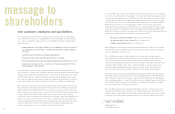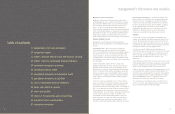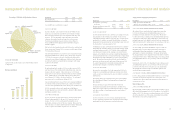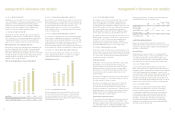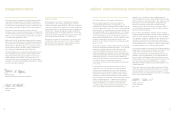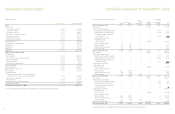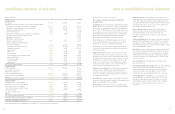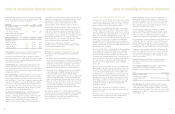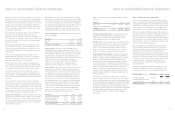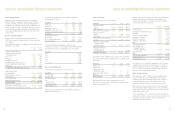Nordstrom 2004 Annual Report Download - page 14
Download and view the complete annual report
Please find page 14 of the 2004 Nordstrom annual report below. You can navigate through the pages in the report by either clicking on the pages listed below, or by using the keyword search tool below to find specific information within the annual report.
assets, income taxes, post-retirement benefits, contingent liabilities
and litigation. We base our estimates on historical experience and
on other assumptions that we believe to be reasonable under the
circumstances. Actual results may differ from these estimates.
The following discussion highlights the policies we feel are critical.
Off-Balance Sheet Financing
Our co-branded Nordstrom VISA credit card receivables are transferred
to a third-party trust on a daily basis. The balance of the receivables
transferred to the trust fluctuates as new receivables are generated
and old receivables are retired (through payments received, charge-offs,
or credits from merchandise returns). The trust issues securities that
are backed by the receivables. Certain of these securities or “beneficial
interests” are sold to third-party investors and those remaining
securities are issued to us.
We recognize gains or losses on the sale of the co-branded Nordstrom
VISA receivables to the trust based on the difference between the
face value of the receivables sold and the estimated fair value of the
assets created in the securitization process. The fair value of the
assets is calculated as the present value of their expected cash flows.
The internal rate of returns used to calculate fair value represent
the volatility and risk of the assets. Assumptions and judgments are
made to estimate the fair value of our investment in asset backed
securities. We have no other off-balance sheet transactions.
Inventory
Our inventory is stated at the lower of cost or market using the retail
inventory method (first-in, first-out basis). Under the retail method,
inventory is valued by applying a cost-to-retail ratio to the ending
inventory’s retail value. As our inventory retail value is adjusted
regularly to reflect market conditions, our inventory is valued at the
lower of cost or market. Factors considered in determining markdowns
include current and anticipated demand, customer preferences, age of
the merchandise and fashion trends.
We also reserve for obsolescence based on historical trends and
specific identification. Shrinkage is estimated as a percentage of
sales for the period from the most recent semi-annual inventory count
based on historical shrinkage results.
Revenue Recognition
We recognize revenues net of estimated returns and we exclude sales
taxes. Our retail stores record revenue at the point of sale. Our catalog
and Internet sales include shipping revenue and are recorded when the
merchandise is delivered to the customer. Our sales return liability is
estimated based on historical return rates.
management’s discussion and analysis
Long-term debt includes financing related to the $200.0 million
off-balance sheet receivable backed securities due in April 2007.
In addition to the required debt repayments disclosed above, we
estimate total interest payments of approximately $628.5 million as
of January 29, 2005, being paid over the remaining life of the debt.
Purchase obligations primarily consist of purchase orders for unreceived
goods or services and capital expenditure commitments.
This table excludes the short-term liabilities, other than the current
portion of long-term debt, disclosed on our balance sheets as the
amounts recorded for these items will be paid in the next year.
Other long-term liabilities consist of workers’ compensation and
general liability insurance reserves and postretirement benefits.
The repayment amounts presented above were determined based
on historical payment trends. Other long-term liabilities not requiring
cash payments, such as deferred property and lease credits, were
excluded from the table above.
Dividends
In 2004, we paid dividends of $0.48 per share, our eighth consecutive
annual dividend increase. We paid dividends of $0.41 and $0.38 per
share in fiscal 2003 and 2002.
Liquidity
We maintain a level of liquidity to allow us to cover our seasonal cash
needs and to minimize our need for short-term borrowings. We believe
that our operating cash flows, existing cash and available credit
facilities are sufficient to finance our cash requirements for the next
12 months. We plan to pay the remaining $96.0 million of our 6.7%
medium-term notes due in July 2005 with existing cash and cash
from operations.
Over the long term, we manage our cash and capital structure to
maximize shareholder return, strengthen our financial position and
maintain flexibility for future strategic initiatives. We continuously
assess our debt and leverage levels, capital expenditure requirements,
principal debt payments, dividend payouts, potential share repurchases,
and future investments or acquisitions. We believe our operating cash
flows, existing cash and available credit facilities, as well as any
potential future borrowing facilities will be sufficient to fund these
scheduled future payments and potential long term initiatives.
CRITICAL ACCOUNTING POLICIES
The preparation of our financial statements requires that we make
estimates and judgments that affect the reported amounts of assets,
liabilities, revenues and expenses, and disclosure of contingent assets
and liabilities. We regularly evaluate our estimates including those
related to off-balance sheet financing, inventory valuation, sales return
accruals, self-insurance liabilities, doubtful accounts, intangible
management’s discussion and analysis
Vendor Allowances
We receive allowances from merchandise vendors for purchase price
adjustments, cooperative advertising programs, cosmetic selling
expenses and vendor sponsored contests. Purchase price adjustments
are recorded as a reduction of cost of sales after an agreement with
the vendor is executed and the related merchandise has been sold.
Allowances for cooperative advertising programs and vendor sponsored
contests are recorded in cost of sales and selling, general and
administrative expenses as a reduction to the related cost when
incurred. Allowances for cosmetic selling expenses are recorded in
selling, general and administrative expenses as a reduction to the
related cost when incurred. Any allowances in excess of actual costs
incurred that are recorded in selling, general and administrative
expenses are recorded as a reduction to cost of sales.
Self Insurance
We are self insured for certain losses related to health and welfare,
workers’ compensation and general liability. We record estimates
of the total cost of claims incurred as of the balance sheet date.
These estimates are based on internal analysis of historical data
and validated by independent actuarial estimates.
Allowance For Doubtful Accounts
Our allowance for doubtful accounts represents our best estimate
of the losses inherent in our private label credit card receivable as of
the balance sheet date. We evaluate the collectibility of our accounts
receivable based on several factors, including historical trends of
aging of accounts, write-off experience and expectations of future
performance. We recognize finance charges on delinquent accounts
until the account is written off. Delinquent accounts are written off
when they are determined to be uncollectible, usually after the passage
of 151 days without receiving a full scheduled monthly payment.
Accounts are written off sooner in the event of customer bankruptcy
or other circumstances that make further collection unlikely. Our
write-off experience and aging trends have been consistent over the
last two years.
Valuation of Long-Lived Assets
We review our intangibles and other long-lived assets annually for
impairment or when events or changes in circumstances indicate
the carrying value of these assets may not be recoverable. We estimate
the fair value of an asset based on the future cash flows the asset
is expected to generate. An impairment loss is recognized when the
carrying value of the asset exceeds its fair value. Factors used in the
valuation of long-lived assets include, but are not limited to,
management’s plans for future operations, recent operating results
and projected cash flows.
Recent Accounting Pronouncements
In November 2004, the FASB issued SFAS No. 151, “Inventory Costs an
amendment of ARB No. 43, Chapter 4.” SFAS 151 amends ARB No. 43,
Chapter 4, “Inventory Pricing” to clarify that abnormal amounts of idle
facility expense, freight, handling costs, and wasted material should
be recognized as current period charges. In addition, this statement
requires that fixed overhead production be allocated to the costs of
conversion based on the normal capacity of the production facilities.
SFAS 151 is effective for inventory costs incurred during fiscal years
beginning after June 15, 2005, and should be applied prospectively.
We do not believe the adoption of SFAS 151 will have a material
impact on our financial statements.
In December 2004, the FASB issued SFAS No. 123R, “Share-Based
Payment.” SFAS 123R requires us to measure the cost of employee
services received in exchange for an award of equity instruments based
on the grant-date fair value of the award. That cost will be recognized
over the period during which an employee is required to provide services
in exchange for the award. We have not yet quantified the effects of
the adoption of SFAS 123R, but it is expected that the new standard will
result in significant stock-based compensation expense. SFAS 123R
will be effective for our third fiscal quarter beginning July 31, 2005.
Cautionary Statement
The preceding disclosures included forward-looking statements
regarding our performance, liquidity, capital expenditures and adequacy
of capital resources. These statements are based on our current
assumptions and expectations and are subject to certain risks and
uncertainties that could cause actual results to differ materially from
those projected. Forward-looking statements are qualified by the risks
and challenges posed by our ability to predict fashion trends, consumer
apparel buying patterns, our ability to control costs, weather conditions,
hazards of nature, trends in personal bankruptcies and bad debt
write-offs, changes in interest rates, employee relations, our ability
to continue our expansion plans, potential opportunities that may be
related to the current changes in our industry, changes in governmental
or regulatory requirements, and the impact of economic and competitive
market forces, including the impact of terrorist activity or the impact of
a war on us, our customers and the retail industry. As a result, while
we believe there is a reasonable basis for the forward-looking
statements, you should not place undue reliance on those statements.
We undertake no obligation to update or revise any forward-looking
statements to reflect subsequent events, new information or future
circumstances. This discussion and analysis should be read in
conjunction with the consolidated financial statements and the
eleven-year statistical summary.
25
24







